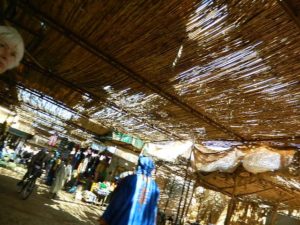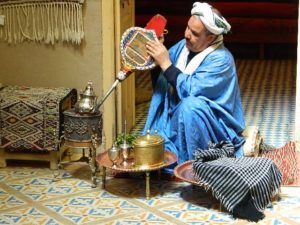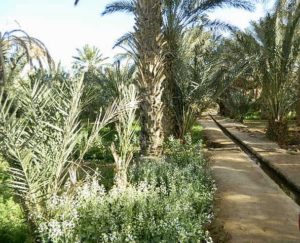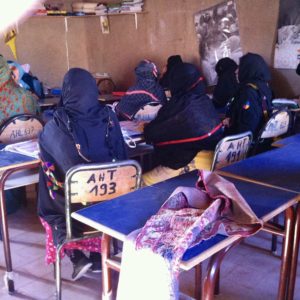We’re driving across what used to be ocean floor — 500 million years ago. Now it’s a waterless, perfectly flat plain where miners dig shallow trenches in search of ancient fossils. We stop at Macro Fossils Kasbah and marvel at the perfection of squid-like ammonites and trilobites looking something like horseshoe crabs. They’re encased in stone, from ebony black through lightest beige, their delicate forms revealed  through the painstaking work of craftsman, and polished to mirror finishes. We fantasize about a dining table, or perhaps a bathtub to share with the ancient creatures. We content ourselves with much smaller purchases.
through the painstaking work of craftsman, and polished to mirror finishes. We fantasize about a dining table, or perhaps a bathtub to share with the ancient creatures. We content ourselves with much smaller purchases.
Rissani, and a visit to the souq set up under reed  mats, the sun striping the fruits and veg and spices, most of which arrived here this morning via the
mats, the sun striping the fruits and veg and spices, most of which arrived here this morning via the  donkeys waiting in Rissani’s parking lot.
donkeys waiting in Rissani’s parking lot.
We’re served artisanally prepared tea in the rug shop where some of us  succumb to temptation.
succumb to temptation.
Post-lunch, our four wheel drive vehicles are waiting. There are no roads to Merzouga and the dunes, no landmarks, nothing but packed sand and some vague tracks — but we have faith that our drivers have done this before. In the midst of this nothingness, we’re suddenly surrounded by brightly painted Fiat 500s, garish beetles speeding past us across the desert in a road race that ends in Marrakesh. Surreal.
Merzouga — 35 miles from the  Algerian border. Green in the middle of the desert, irrigated by small channels that criss-cross the sand, that tap the largest underground reservoir of water in Morocco.
Algerian border. Green in the middle of the desert, irrigated by small channels that criss-cross the sand, that tap the largest underground reservoir of water in Morocco.
We visit a girls school — basic literacy and sewing.
Next up? A sunset camel ride in the dunes. Is this a good idea?

“In the midst of this nothingness, we’re suddenly surrounded by brightly painted Fiat 500s” — Love this, & your continuing travels (continuing soon, I hope).
The Fiats were something of a shock. We catch up with them in Marrakesh.